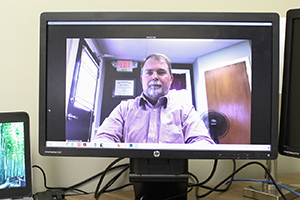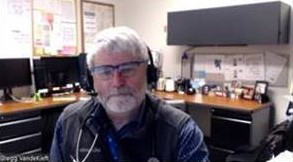BY LISA EISENHAUER
Updated April 17, 2020
Early this year, when novel coronavirus still felt like a distant threat, Dr. Thomas Coburn was helping to plan a telehealth option for the Lexington, Kentucky-based CHI Saint Joseph Medical Group.

Dr. Thomas Coburn, a family practitioner, appears on his own computer screen as he conducts a virtual visit with a patient from his office in Wilmore, Kentucky. Coburn helped set up the telehealth system he and his colleagues in the CHI Saint Joseph Medical Group, which is based in Lexington, Kentucky, started using in late March.
Coburn, the group's medical director for information technology and informatics, says that while he was confident that virtual care could become a vital tool, especially for rural care providers like him, he was unsure it would be embraced by all of the group's more than 240 providers that include physicians and advanced practice providers or by the patients served by his family practice in Wilmore, Kentucky.
When alarms started sounding about the potential for the rapid spread of novel coronavirus in the U.S., the medical group sped up its telehealth implementation plans. On March 30, it gave all of the providers access to a HIPAA-compliant telemedicine platform offered by the video conferencing app Zoom.
The app allowed the medical group to have the virtual visits mirror the sequencing of in-person visits. Patients still first talk with someone on the office's front-desk staff and then with a clinical assistant before being moved into a virtual waiting room where the doctor or nurse practitioner invites them into a private video conference. "We tried to make this as simple and straightforward as possible and the least disruptive to their normal workflows so that they feel really comfortable doing it," Coburn said. "And so far, it has been a big success."
By the fourth day as the state was about a week into an order from the governor to stay home, about 600 of the group practice's total of about 1,300 appointments were by videoconference or by phone. Coburn and his partner began seeing their patients almost exclusively through the Zoom platform. He said his patients have for the most part been grateful they don't have to leave their homes in the middle of national health emergency and risk potential exposure to the virus in order to see the doctor. For medical needs that can't be addressed virtually, such as a suture removal, Coburn says his office is staggering appointments, so patients come to the office one at a time.
Patients without computers or smartphones can opt for audio-only visits using their "dumbphone."
Health systems and clinicians' groups across the country with mature telehealth practices that are serving rural patients including Avera Health, CHRISTUS Health and Hospital Sisters Health System, have announced major expansions of telehealth care and the addition of other Internet-based tools such as self-screenings that lead patients through a series of questions to assess whether their symptoms are indicative of COVID-19, the illness caused by the coronavirus.
Providence St. Joseph Health has been setting up providers to conduct video visits with patients at home over the past several years, primarily specialists seeing patients in rural areas. With COVID-19 and the need for social isolation, the system added the option of video visits for more than 7,000 providers within its system on March 24. On March 2, the system recorded two video visits. The daily average for the week of April 5-10 was 4,023. The system also saw the number of visits done by phone climb from zero on March 1 to a daily average of 5,638 the week of April 5-10.
Pedal to the floor
The COVID-19 pandemic prompted the Centers for Medicare and Medicaid Services to issue a waiver on March 17 retroactive to March 6 that lets Medicare cover the tab for video and audio-only telehealth services nationwide from a range of providers and allows patients to get the services from home. Before, CMS would only pay for telehealth visits for patients in certain rural areas and only if those patients went to specific medical facilities for the televisits. The federal government also eased rules on physicians practicing across state lines, which potentially eased staffing hurdles for some telemedicine providers.
The CARES Act passed by Congress in response to the pandemic includes $200 million in funding to help nonprofit providers purchase telecommunications, broadband connectivity, and devices necessary for providing telehealth services. Specific information and application procedures are posted on a website set up by the Federal Communications Commission.
Another factor fueling the telehealth wave is the need to isolate patients with confirmed or suspected COVID-19 diagnoses. Telehealth allows those patients with mild symptoms to be cared for and monitored at home under a doctor's supervision.
For workers at clinics and doctors' offices, virtual visits reduce their risk of being either sickened or forced into quarantine.
Putting virtual care into practice
Dr. Gregg VandeKieft, a palliative care specialist with Providence St. Joseph, began seeing clients through televisits for the first time in recent weeks. "We've been trying to get tele-palliative care developed for a couple of years," said VandeKieft, whose practice is based in Olympia, Washington. "The CMS waivers, and probably more to the point, the needs of the COVID pandemic have really, really accelerated the process."

Dr. Gregg VandeKieft, a palliative care specialist with Providence St. Joseph Health, talks to a patient's sons who were in two different states during a care planning meeting. He is among the many clinicians using the Zoom videoconferencing app for virtual appointments.
In one of his first virtual appointments, VandeKieft met via Zoom with three sons of a hospitalized patient, who chose not to be part of the meeting. Two of the sons were in Washington state and one was in Alaska.
"I felt like we covered everything as effectively as we would've if all three sons had been in a family meeting room with me at the hospital," said VandeKieft, who is associate medical director of Providence St. Joseph Health's Institute for Human Caring.
The next day, he had a first meeting with a new patient with end-stage lung disease and her life partner by phone. That conversation ranged from medical management of her symptoms as death becomes imminent, to how she could update her estranged children on her condition, to how to get her life partner legally empowered as her health decision maker, to questions about the state's Death with Dignity Act. (Providence St. Joseph and other Catholic health systems abide by ethical and religious directives that prohibit the dispensing of lethal drugs to patients at the end of life.)
"We did all this on the telephone and we've never met in person and yet by the end of the encounter I felt like, 'Wow. We went deep and we covered what I needed to cover with her as a palliative care specialist,'" VandeKieft said.
Tech literacy
Michael Drummond, external affairs and communications director at the institute based in Gardena, California, says the care and outreach that palliative care clinicians spread across Providence St. Joseph's seven-state system are providing through remote means began at the same time as the system was launching several other digital innovations "to offer more humanized care" amid the pandemic.
One of those tools is Twistle, an online platform for remote patient monitoring. In addition, the system has purchased IPads for skilled care centers from Anchorage to Los Angeles to help keep patients connected with loved ones while no-visitor rules are in place.
Even once COVID-19 is conquered, Drummond, VandeKieft and others expect telehealth to continue to be a big part of modern medical care. They point to its convenience and to the fact that Americans are becoming more and more at ease with technology. "Between people's experience with FaceTime and relating to grandchildren and family members that way, and people's understanding of the unique nature of things these days and during the COVID pandemic, every family I've encountered has been completely understanding about it," VandeKieft said.
Coburn, the Kentucky family practitioner, said even most of his older patients who haven't had email and smartphones around for most of their lives are adapting to e-visits. One 83-year-old patient was initially convinced she could never figure out how to set up a televisit through her smartphone. But after his assistant talked the woman through the downloading of the app, the appointment went off without any problems.
"We took care of the issue that she had, but I did want to see her and follow up a week later," Coburn said. "So, a week later she called up or we called her to walk her through and she says, 'Oh, I've got this.'"
Coburn foresees even wider use for telehealth, especially in rural settings like his. He expects to one day be able to connect his patients to distant specialists from their home or from his office and to use digital tools that transmit medical information about the patient to himself and the specialists in real time. "We actually can use telemedicine to get that specialist into that meeting right then and there to determine what needs to happen next," Coburn said.
Even with his high expectations for telemedicine, he thinks it should never completely replace in-person care.
"There's something about personal touch, there's something about connecting with people, there's something about being able to be face to face and be able to hear and listen and connect with people so that the in-person visit will always be a part of how we do medicine," he said. "I fully believe that."